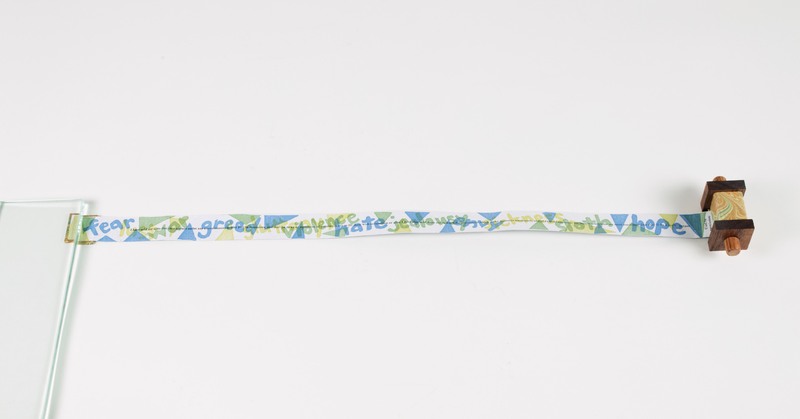A87. Pandora's Box
A87. Kurt Vonnegut. Pandora’s Box. Santa Cruz, California: Peter & Donna Thomas, 1997.
63.5 x 25.5 mm (2½” x 1”), scroll 42 cm (16 ½"), 130 copies.
Binding: Scroll, bound in a box made of marbled paper over boards set between two wood blocks. A slit is cut into the top of the box. Title in gold on cover board. Scroll rolls up inside box, on a wooden dowel that passes through holes in the blocks. Wooden knobs attached to ends of dowel aid in turning. The other end of the scroll is attached to a board covered in marbled paper, which remains outside the box acting as both cover/title, and handle to grasp while unwinding. Paper: Duplex sheet; white on front and blue on reverse, handmade by Peter Thomas. Printing: Letterpress. Typography: Hand set, typeface unknown. Linocut lettering by Donna Thomas; printed in blue, green, and yellow.
“The text is a quote from Vonnegut’s Slaughter House Five. As I read it, what he wrote seemed like the hope in the bottom of Pandora’s box, and I thought to print it on an accordion that was bound with some sort of jack-in-the-box mechanism so it would pop out. But the project did not have first priority. Several years passed and, as I used the scroll structure in other projects, l realized my reference to the Greek myth would be better represented by a scrolling book. I devised a way to modify a clamshell box to hold the scroll. When the scroll is pulled out, Donna’s illustrations of the evils, represented by linocut words, are released. But hope, represented by a line of 6 pt type with Vonnegut’s quote runs through the evils, so when the scroll is fully out, the final word is that of hope.
This was a breakthrough book for us, as it reframed our relationship, as book artists, to text. As fine press printers we had been taught to see the text as primary, the book is only a beautiful vehicle to house the text. With this book, the text inspired us, but the concept and structure were the real driving force. We used a great work of literature, a sentence from one anyway, but much like collage artists, we reinterpreted it and used it to our own aesthetic ends. We saw this as a mutually beneficial use: we used Vonnegut’s creation, his words, and those words benefitted from us using them, as we brought them to a new audience who may otherwise never thought to read his writings.”
